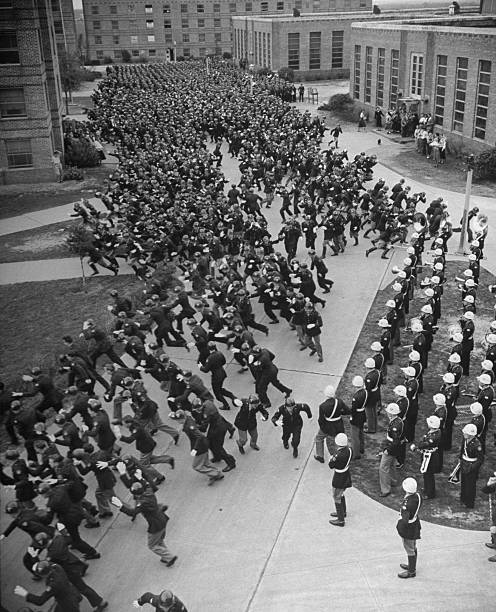Nonequilibrium effects in hybrids of electron systems with spontaneously broken symmetries
Imagine a military regiment in formation. That we will call symmetry. Now imagine the same regiment when it is dismissed by the commanding officer: at once the soldiers disperse and tend to form domains (groups) or pairs. Hence, we can say that the symmetry is spontaneously broken. Both superconductors and ferromagnets are examples of electron systems with spontaneously broken symmetries and thereby characterized by order parameters. In both cases the commanding officer is temperature.

Superconductors
At low temperatures, the resistivity of a metal (the inverse of its conductivity) is nearly constant. As the temperature of a material is lowered and as we approach absolute zero the resistivity should approach a constant value. Many metals, known as normal metals, behave in this way.
The behaviour of another class of metals and some other materials is quite different. These metals behave normally as the temperature is decreased, but at some critical temperature (which depends on the properties of the metal), the resistivity drops suddenly to zero. These materials are known as superconductors. The resistivity of a superconductor is not merely very small at temperatures below the critical temperature; it vanishes! Such materials can conduct electric currents even in the absence of an applied voltage, and the conduction occurs with no joule heating losses.
Conspicuously absent from the list of superconductors are the best metallic conductors (Cu, Ag, Au), which suggests that superconductivity is not caused by a good conductor getting better but instead must involve some fundamental change in the material. In fact, superconductivity results from a kind of paradox: ordinary materials can be good conductors if the electrons have a relatively weak interaction with the lattice, but superconductivity results from a strong interaction between the electrons and the lattice.
Consider an electron moving through the lattice. As it moves, it attracts the positive ions and disturbs the lattice, much as a boat moving through water creates a wake. These disturbances propagate as lattice vibrations, which can then interact with another electron. In effect, two electrons interact with one another through the intermediary of the lattice; the electrons move in correlated pairs (called Cooper pairs) that do not lose energy by interacting with the lattice. The order parameter for a conventional superconductor is then the amplitude of the Cooper pairing between electrons in states with opposite spins and momenta.
Ferromagnets
On the other hand, materials can be classified according to how they behave under an applied magnetic field. One of these categories is ferromagnetism. In ferromagnetic substances, within a certain temperature range, there are net atomic magnetic moments, which line up in such a way that magnetization persists after the removal of the applied field .
Below a certain temperature, called the Curie point (or Curie temperature), an increasing magnetic field applied to a ferromagnetic substance will cause increasing magnetization to a high value, called the saturation magnetization. This is because ferromagnetic substances consists of small magnetized regions called domains.
The main defining features of ferromagnets are the broken spin-rotation symmetry into the direction of magnetization and the associated exchange energy h that splits the spin-up and spin-down spectra. This also leads to a strong spin dependence (spin polarization) of the observables related to ferromagnets.
Together
There are two mechanisms that prevent most of the ferromagnetic materials from becoming superconducting. One of them is the orbital effect due to the intrinsic magnetic field in ferromagnets. When this field exceeds a certain critical value, superconductivity is suppressed . The second mechanism is the paramagnetic effect. This is due to the intrinsic exchange field of the ferromagnet that shows up as a splitting of the energy levels of spin-up and spin-down electrons and hence prevents the formation of Cooper pairs.
Now, Sebastian Bergeret (CFM & DIPC) and others summarize 1 what we already know about the regime where this spin-splitting field is present, but not yet too large to kill superconductivity, in a paper published in Reviews of Modern Physics.
The researchers focus on transport and thermal properties of superconducting hybrid structures with a spin-split density of states. Such a splitting can be achieved either by an external magnetic field or, more interestingly, by placing a ferromagnetic insulator adjacent to a superconducting layer.
Several experimental situations are discussed using a theoretical framework based on the quasiclassical formalism, with which both thermodynamical and nonequilibrium properties of such hybrid structures can be accounted for. In order to cover effects beyond quasiclassics, as, for example, strong spin polarization, the researchers combine the quasiclassical equations with effective boundary conditions.
Bergeret et al show that the combination between superconductivity and magnetism requires, on the one hand, a description of additional nonequilibrium modes, spin and spin energy, and, on the other hand, to couple them all. This leads to novel and intriguing phenomena with direct impact on the latest research activities and proposed future technologies based on superconductors and spin-dependent fields.
Author: César Tomé López is a science writer and the editor of Mapping Ignorance.
References
- F. Sebastian Bergeret, Mikhail Silaev, Pauli Virtanen, and Tero T. Heikkilä (2018) Colloquium: Nonequilibrium effects in superconductors with a spin-splitting field Reviews of Modern Physics doi: 10.1103/RevModPhys.90.041001 ↩